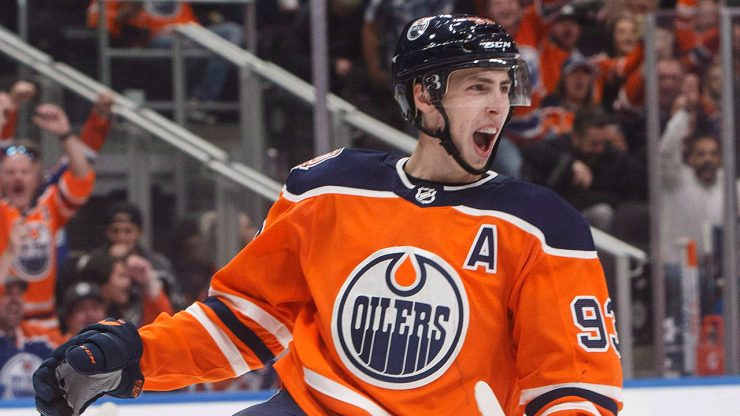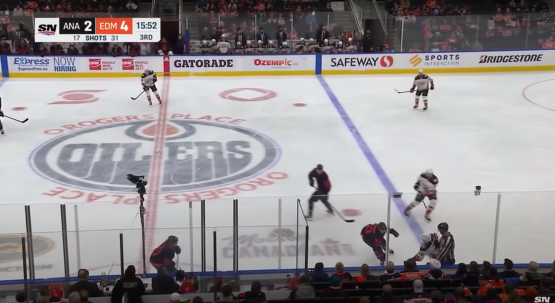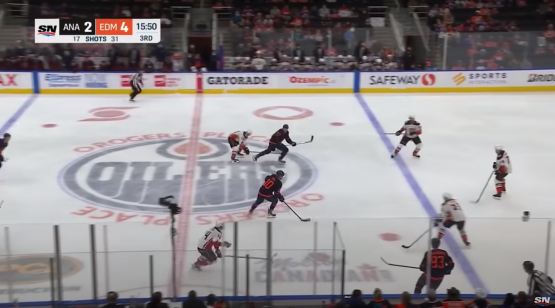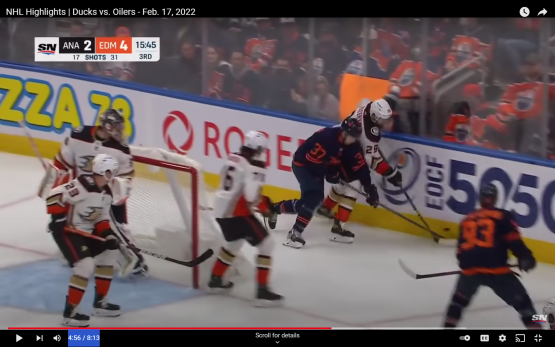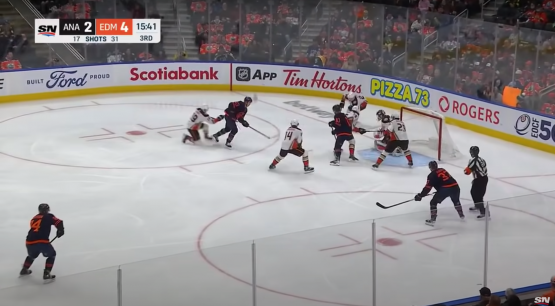It would be categorically untrue to attribute it entirely to new Oilers Coach Woodcroft, but the truth is that RNH is excelling in a role behind McDavid and Draisaitl. Sure, large portions of the fan base have suggested that exactly such a move would be beneficial, but how several dominoes have fallen into place has been instrumental in fully supporting the transition.
The additions of Kane and Hyman since last season’s playoff exit has given the Oilers a much needed bolstering of talent. The two are both proven commodities as solid top 6 contributors, complementing the MVP centres as well as a pair of ascending talents in Puljujarvi and Yamamoto. Without Kane and Hyman RNH’s talents were almost required on the wing as the Oilers tried to string together a top 6 that could contribute. The farther down the lineup, the more the talent was stretched thin. This became all too obvious when looking at numbers such as goal differentials without 97 or 29 on the ice.
Not to be overlooked, RNH’s individual talents have refined as well. Once a slender, offensive playmaker picked 1st overall in the Entry Draft, Nugent-Hopkins has honed his craft and rounded out his game in ways that most would not have expected. Through nearly a dozen head coaches and a near constant state of disappointment a reliable, responsible, and consistent two-way player has emerged.
It’s not that his game isn’t beyond reproach, even earlier this season in the gloom of a terrible December many were focused on the lack of goals from the bulk of the Oilers roster, RNH included. He’s not a perfect player, especially when compared to the surreal talents of McDavid and Draisaitl, and goal scoring is definitely an area that RNH will struggle with compared to the stronger parts of his skillset. In short, it’s not very productive to try to measure the centre’s effectiveness with goal totals.
Instead Nugent-Hopkins has leveraged his high “hockey IQ”, or hockey sense, to become a player that can drive play in all three zones and both special teams. Whether it’s to support breakouts in the defensive zone or to create offensive chances off of turnovers on the forecheck, RNH uses a smart, efficient, short passing game and strong, anticipatory positioning to aid and support his teammates. Especially against the weaker quality of opponents that being lower in the lineup affords, RNH is often able to enact his will on the flow of play, like a conductor.
Of course, hockey is a team game, and any centre would appreciate some symbiotic relationships with their linemates. At the moment, early into the Woodcroft era, RNH has been on a line with Foegele and Ryan on what one would call the Oilers third line.
At first glance it doesn’t quite look like a trio fits the archetype of a third line, often thought of as a role that requires a balance of snarl, nastiness, and physicality. Neither Nugent-Hopkins or Ryan can help much in this area. Of course this rough and tumble characterization is a bit outdated, and as the league has become more focused on skill and less focused on pugilism, so too has the requirements of checking lines.
With more data and specific metrics, such as expected goals, we are starting to evolve our understanding of what constitutes defensive impact. It’s natural to assume or perceive that the best defenders would be physical and responsible in their own zone, which of course does help in-zone defending. This, however, is only part of the equation.
In fact, many expected goals models value creating turnovers off of the forecheck and through transition much more than in zone-defending. It is logical, halting an opponent’s breakout not only cuts off any threat more than 100 feet from one’s own net, it also delivers your team a glorious attacking opportunity, often with the opposing team headed in the wrong direction. It’s for this reason players such as Colorado’s Valeri Nichushkin grade so highly in these flow-of-play metrics.
This helps explain some of how and why the line of Foegele-RNH-Ryan has been so effective. Foegele plays an honest, straightforward game, and brings some of the requisite speed and physicality needed based on the limitations of his linemates, while Ryan plays a very smart positional game, which has allowed in him post very strong possession numbers in bottom 6 roles over the past several seasons.
However, it might be more effective to show you how this all comes together, and a perfect example resulted in a Foegele goal on February 17th against the Ducks, which you can watch in real time here.
Frame 1. As promised, this play starts in transition, as the Ducks have the puck and are looking to get through the neutral zone and onto the attack. The Oilers are in a good defensive structure, which at least in this still frame looks like a 1-2-2. Regardless, RNH is able to pressure the Anaheim puck carrier, while Ryan is able to seal the wall. The Ducks player (Steel) feels the pressure and tries to make a safe play up the wall into the waiting arms of Ryan.
Frame 2. We see the Oilers begin their attack. The puck carrier, Ryan, elects to initiate a dump and chase. Given the velocities of all the players it’s a smart move to get the defence turned around, as 3 Ducks are spread across the blueline, but it’s also a maneuver Ryan is able to execute with tact and deftness. Foegele is already beginning his charge for the loose puck, giving him enough speed to take away any time the Ducks defender might have on a retrieval.
Frame 3. We can see the fruits of Foegele’s forecheck as the Ducks defender (Pateryn) has no choice but to try to shield the puck. The other 2 Ducks defenders (Mahura and Steel) are stuck trying to read who will win the battle, prioritizing net front coverage as Ryan drives the crease. This allows RNH to swoop in as the third man into the puck battle and come away with possession and speed where Steel tries to follow him behind the net.
Frame 4. The forth and final frame shows RNH’s vision and playmaking abilities. From the moment he picks up the puck he’s able to get moving towards the back post, another directional change the Ducks have to account for. Upon emerging from the other side he’s quickly able to see past the mayhem in front to spot a wide open Foegele for a tap in goal. All 6 Ducks are fixated on Nugent-Hopkins.
Perhaps against stronger competition the turnover and coverage mistakes by the Ducks don’t happen. Regardless, RNH is able to weaponize the strong, simple, fundamental play of his linemates into the highest quality of chances. Not only was the Ducks attack thwarted but it was quickly turned into offence.
Add The Sports Daily to your Google News Feed!
